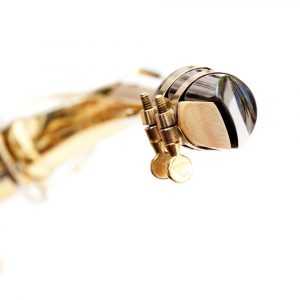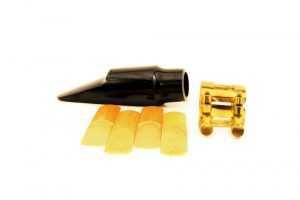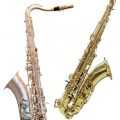A saxophone player’s sound is a saxophone player’s identity. It’s what defines them. Hear one or two notes and you can tell if it’s Coltrane, or Parker, or Rollins, or Getz. What’s the key to getting a great sound? Long tones, overtone exercises, listening to players you want to sound like (especially live), practicing often, performing with other musicians frequently, etc. If you don’t have a good set-up, though, you’re giving yourself a pretty limiting handicap from the start. Your teachers may stress the importance of getting a good horn, but your reed/mouthpiece set-up is of at least equal importance. Some people even argue that the saxophone mouthpiece is the most important piece of equipment in determining a player’s sound.

Unfortunately, that stock saxophone mouthpiece that came with your horn is probably not a good piece of equipment. I know you paid a lot for your horn, but the mouthpiece that came with it is most likely nothing more than a cheap added extra to make the horn at least playable. No, you didn’t get ripped off. A stock mouthpiece is fine for a beginner, but you will grow out of it quickly; no professional player uses a stock mouthpiece. In defense of saxophone manufacturers though, it wouldn’t make any sense to have a nice mouthpiece come with a brand new horn. There are such a wide variety of saxophone mouthpieces out there and each person is highly individualistic. Each person is built differently. Some people sound good using a mouthpiece with a wide tip opening in combination with soft reeds; some people prefer using a mouthpiece with a narrow tip opening in combination with harder reeds.
Sound familiar? Experiencing a bit of déjà vu? I wrote a little bit about this already in my “Saxophone Reed Strength” article. Similar to saxophone reeds, saxophone mouthpieces have numerous options to choose from. There is no “one-size-fits-all” solution. Each person is built differently, so each person needs different equipment to be comfortable and to sound their best. Because of this, saxophone mouthpieces come in a variety of sizes, are made of different materials, are manufactured by several companies, and are produced with different purposes and applications in mind.
Choosing Your Mouthpiece
So, how do you go about choosing which saxophone mouthpiece is a good fit for you? What’s the easiest and most efficient way to go about it? As I said above, this is not an easy “one-size-fits-all” scenario. Two people playing the exact same saxophone/mouthpiece/reed set-up could sound surprisingly different. Similarly, two people playing completely different set-ups could end up sounding very similar.

Saxophone mouthpieces come in a variety of different sizes and are made of different materials. The size of each mouthpiece refers to the tip opening. Like reeds, different mouthpiece brands have different ways of referring to the size of the tip opening, usually either numerical or alphabetical. The sizing usually comes at the end of the name of the mouthpiece (ex: Meyer 5 or Selmer S80 C*). The most common material that mouthpieces are made out of is ebonite (or hard rubber). Most players use ebonite mouthpieces. The next most common material mouthpieces are made out of is metal. There are less common mouthpieces made out of glass, wood, etc. Relatively speaking, not many players use these types of mouthpieces.
Trying out saxophone mouthpieces can be a lengthy and involved process. Like trying out a horn, you should play many mouthpieces to figure out which one is right for you. You’re probably thinking: how does that work? And doesn’t that get expensive? Lucky for you, many stores are aware of the fact that finding the right saxophone mouthpiece is a process. Many stores will either let you try out mouthpieces in the store or take home a few mouthpieces for a trial period (usually 7 to 14 days).
Classical Mouthpiece vs. Jazz Mouthpiece
Saxophone mouthpieces are made with different purposes and applications in mind. Many jazz players play classical and vice versa. Young students usually start out playing classical and then venture to jazz, but still practice classical as a basis for good technique. A lot of colleges even combine jazz and classical curricula. There are even a few professional saxophone players that are known for playing both classical and jazz. If you plan on playing both classical and jazz saxophone, it’s a good idea to have a mouthpiece for each style. Many players who play multiple genres of music use different saxophone mouthpieces for classical and for jazz. The ideal saxophone tones for classical and jazz are very different, and specific mouthpieces are designed with this in mind.
Saxophone Mouthpiece Recommendations
There are so many different saxophone mouthpieces out there, but there are some popular ones that both beginners and professionals use. If you’re in the market for a mouthpiece, here are a few recommendations to get you started:
Classical: Semler S80 (C*), Selmer S90 (180), Rousseau New Classic (NC4), Vandoren Optimum (AL3).
Jazz: Vandoren V16 (6), Meyer (5), Jody Jazz, Selmer Super Session (F)
Metal: Otto Link (7)
The sizing I’ve recommended for each mouthpiece (in parenthesis) is what I believe to be the average size that players most often use. If you like the mouthpiece, you should test out the size below and the size above as well.
Some saxophone players swear by vintage mouthpieces. Others get saxophone mouthpieces custom made for them. It’s all very personal, but as a beginner/intermediate player, these should work fine.
Conclusion
 It can be fun to look up what set-ups your favorite saxophone players use. That information is often pretty readily available. Many pros publish their saxophone/mouthpiece/reed set-up on their websites. If they don’t, chances are someone that has worked with them or has taken lessons from them has posted their set-up on one forum or another. But, that information is not necessarily useful. Some people say they mimic their favorite player’s set-up because “then the only limitation holding me back from sounding exactly like them is me.” In a way, that’s true. But it’s much more complicated than it sounds. If you play the exact horn, mouthpiece, and reed that your favorite player had just played on, then technically you would be the only limitation. But there’s not much you can do about that. You can’t change the shape of your oral cavity. I’ve played on someone’s horn immediately after them. They had a nice fat sound and I couldn’t even produce a note because the reed was too soft and the mouthpiece was too narrow for me.
It can be fun to look up what set-ups your favorite saxophone players use. That information is often pretty readily available. Many pros publish their saxophone/mouthpiece/reed set-up on their websites. If they don’t, chances are someone that has worked with them or has taken lessons from them has posted their set-up on one forum or another. But, that information is not necessarily useful. Some people say they mimic their favorite player’s set-up because “then the only limitation holding me back from sounding exactly like them is me.” In a way, that’s true. But it’s much more complicated than it sounds. If you play the exact horn, mouthpiece, and reed that your favorite player had just played on, then technically you would be the only limitation. But there’s not much you can do about that. You can’t change the shape of your oral cavity. I’ve played on someone’s horn immediately after them. They had a nice fat sound and I couldn’t even produce a note because the reed was too soft and the mouthpiece was too narrow for me.
Finding out which saxophone mouthpiece is right for you is a process, sometimes a lengthy one. But, once you figure out your perfect set-up, you will be satisfied (at least for a little while) and sound the best that you can. As with saxophone reeds, the point of finding a good saxophone mouthpiece is so you don’t have to think about saxophone mouthpieces anymore.







